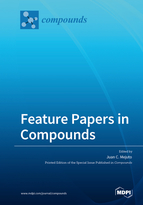Feature Papers in Compounds
A special issue of Compounds (ISSN 2673-6918).
Deadline for manuscript submissions: closed (30 June 2022) | Viewed by 56121
Special Issue Editor
Interests: physical organic and physical inorganic chemistry; reactivity mechanisms in homogeneous and microheterogeneous media; stability of self-assembly aggregates, and supramolecular chemistry
Special Issues, Collections and Topics in MDPI journals
Special Issue Information
Dear Colleagues,
As Editor-in-Chief of Compounds, I am delighted to present this Special Issue of “Feature Papers in Compounds” in the newly launched Compounds journal. Compounds is a new, international, open access and peer-reviewed journal that publishes original research and scholarship, contributing to the expanding field of compounds research. Compounds intends to inform and to stimulate interest and debate in advancing the scientific basis of the discipline.
This Special Issue of Compounds will comprise a collection of high-quality papers published free of charge in open access form by Editorial Board Members and authors invited by the Editorial Office and the Editor-in-Chief. Both original research articles and comprehensive review papers are welcome.
Prof. Dr. Juan Mejuto
Guest Editor
Manuscript Submission Information
Manuscripts should be submitted online at www.mdpi.com by registering and logging in to this website. Once you are registered, click here to go to the submission form. Manuscripts can be submitted until the deadline. All submissions that pass pre-check are peer-reviewed. Accepted papers will be published continuously in the journal (as soon as accepted) and will be listed together on the special issue website. Research articles, review articles as well as short communications are invited. For planned papers, a title and short abstract (about 100 words) can be sent to the Editorial Office for announcement on this website.
Submitted manuscripts should not have been published previously, nor be under consideration for publication elsewhere (except conference proceedings papers). All manuscripts are thoroughly refereed through a single-blind peer-review process. A guide for authors and other relevant information for submission of manuscripts is available on the Instructions for Authors page. Compounds is an international peer-reviewed open access quarterly journal published by MDPI.
Please visit the Instructions for Authors page before submitting a manuscript. The Article Processing Charge (APC) for publication in this open access journal is 1000 CHF (Swiss Francs). Submitted papers should be well formatted and use good English. Authors may use MDPI's English editing service prior to publication or during author revisions.
Keywords
- Organic/inorganic compounds
- Chemistry
- Materials
- Catalysis
- Simulation and modeling
Related Special Issue
- Feature Papers in Compounds (2024) in Compounds (1 article)





